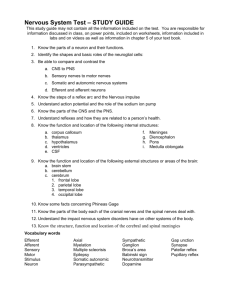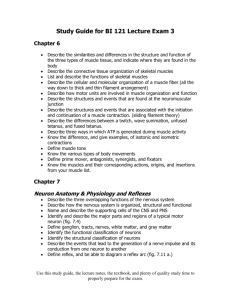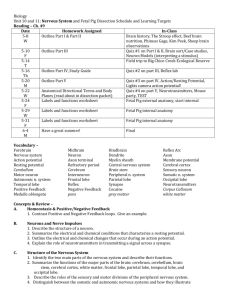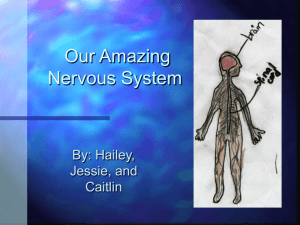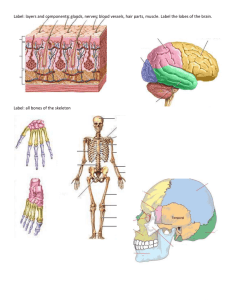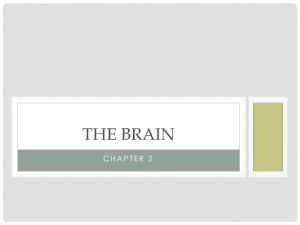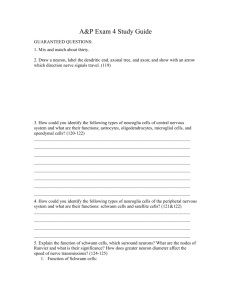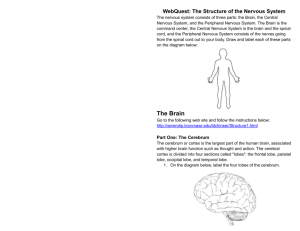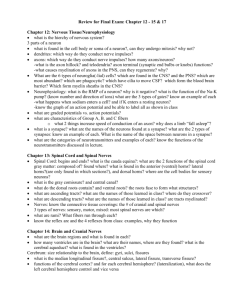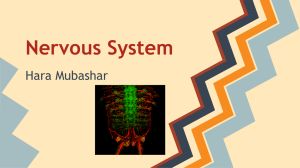Chapter 2
advertisement
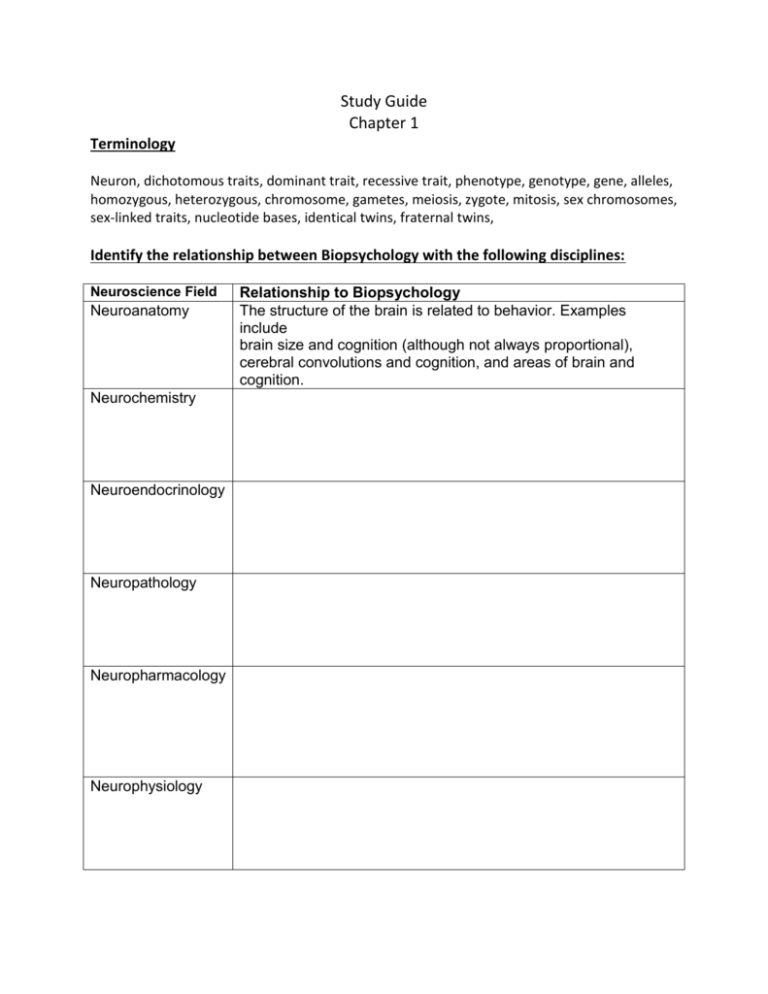
Study Guide Chapter 1 Terminology Neuron, dichotomous traits, dominant trait, recessive trait, phenotype, genotype, gene, alleles, homozygous, heterozygous, chromosome, gametes, meiosis, zygote, mitosis, sex chromosomes, sex-linked traits, nucleotide bases, identical twins, fraternal twins, Identify the relationship between Biopsychology with the following disciplines: Neuroscience Field Neuroanatomy Neurochemistry Neuroendocrinology Neuropathology Neuropharmacology Neurophysiology Relationship to Biopsychology The structure of the brain is related to behavior. Examples include brain size and cognition (although not always proportional), cerebral convolutions and cognition, and areas of brain and cognition. Chapter 2 KEY TERMS (page numbers in Pinel text) afferent nerves (p. 37), amygdala (p. 56), anterior (p. 48), astrocytes (p. 45), autonomic nervous system (ANS) (p. 37), basal ganglia (p. 56), bipolar neuron (p. 43), blood–brain barrier (p. 40), central nervous system (CNS) (p. 37), cerebellum (p. 52), cerebral cortex (p. 54), cerebral ventricles (p. 39), cerebrospinal fluid (CSF) (p. 39), contralateral (p. 54), corpus callosum (p. 55), cranial nerves (p. 38), diencephalon (p. 53), efferent nerves (p. 37), frontal lobe (p. 55), ganglia (p. 44), glial cells (p. 44), hippocampus (p. 56), hypothalamus (p. 53), inferior colliculi (p. 53), interneurons (p. 43), limbic system (p. 56), medulla (p. 51), meninges (p. 39), mesencephalon (p. 53), metencephalon (p. 52), microglia (p. 45), multipolar neuron (p. 43), myelencephalon (p. 51), neocortex (p. 55), nerves (p. 44), nuclei (p. 44), occipital lobe (p. 55), oligodendrocytes (p. 44), parasympathetic nerves (p. 38), parietal lobe (p. 55), peripheral nervous system (PNS) (p. 37), pituitary gland (p. 54), peripheral nervous system (PNS) (p. 37), pons (p. 52), posterior (p. 48), putamen (p. 57), reticular formation (p. 51), Schwann cells (p. 44), somatic nervous system (SNS) (p. 37), striatum (p. 57), substantia nigra (p. 53), superior (p. 48), superior colliculi (p. 53), sympathetic nerves (p. 38), tectum (p. 53), tegmentum (p. 53), telencephalon (p. 54), temporal lobe (p. 55), thalamus (p. 53), tracts (p.44), unipolar neurons (p. 43), ventral (p. 48), ventral horns (p. 49) Know the general layout of the nervous system with different divisions Name the three protective layers of the brain What is the blood-brain barrier? What is the anatomy of the neuron and the function of each component? What are the four classes of Neurons? Know the different types of Glial Cell and their function Know the five divisions of the brain and what structure falls under each division Myelencephalon (medulla): reticular formation, brain stem Metencephalon: reticular formation, pons, cerebellum Mesencephalon: tectum (inferior and superior colliculi), tegmentum (substantia nigra) Diencephalon: thalamus, hypothalamus Telencephalon: cerebral cortex (know the four lobes), corpus callosum, hippocampus, limbic system (amygdala), basal ganglia Know the function of the different parts of the brain Chapter 3 KEY TERMS (page numbers in Pinel text) absolute refractory period (p. 72), acetylcholine (p. 81), action potential (AP) (p 69), agonists (p. 85), all-or-none response (p. 69), amino acids (p. 79), antagonists (p. 85), aspartate (p. 79), axon hillock (p. 69), Botox (p. 88), catecholamines (p. 80), curare (p. 87), depolarize (p. 68), dopamine (p. 79), endorphins (p. 81), epinephrine (p. 79), excitatory postsynaptic potentials (EPSPs) (p. 68), exocytosis (p. 75), gamma-butyric acid (GABA) (p. 79), glutamate (p. 79), glycine (p. 79), hyperpolarize (p. 68), indolamines (p. 80), inhibitory postsynaptic potentials (IPSPs) (p. 68), ion channels (p. 66), ions (p. 66), membrane potential (p. 66), metabotropic receptors (p. 77), microelectrodes (p. 66), neuromuscular junctions (p. 88), neuropeptides (p. 79), neurotoxins (p. 89), nitric oxide (p. 80), nodes of Ranvier (p. 73), nondirected synapses (p. 74), norepinephrine (p. 79), peptides (p. 75), receptors (p. 76), relative refractory period (p. 72), resting potential (p. 66), reuptake (p. 78), second messenger (p. 77), serotonin (p. 80), sodium-potassium pumps (p. 66), soluble gases (p. 80), spatial summation (p. 69), synaptic vesicles (p. 75), temporal summation (p. 69), threshold of excitation (p. 69) What is the resting potential? The ionic basis of resting potential and the distribution What is the millivolt of resting potential and action potential? Know the different types of neurotransmitters and their function. Excitatory or Inhibitory or both
